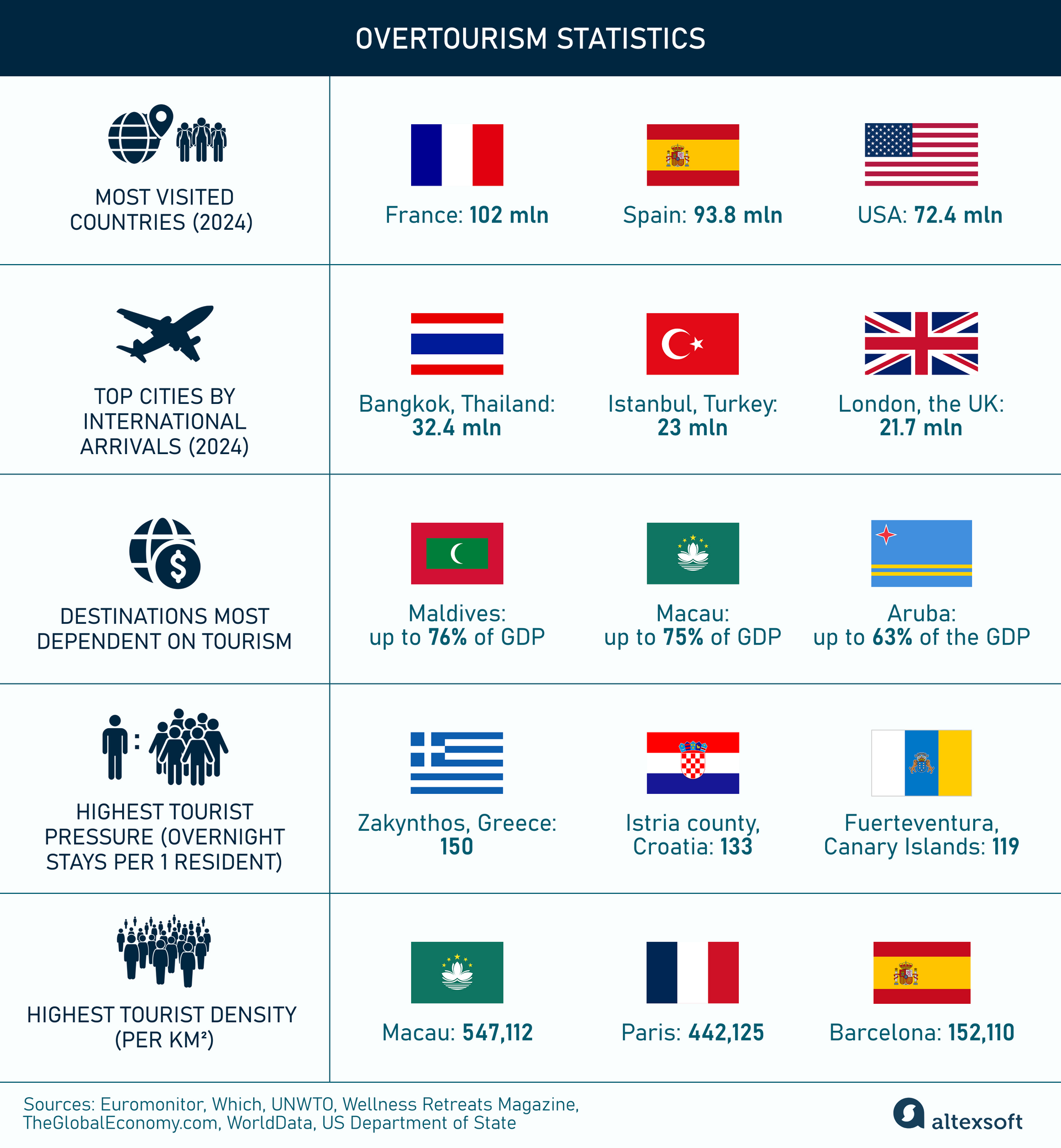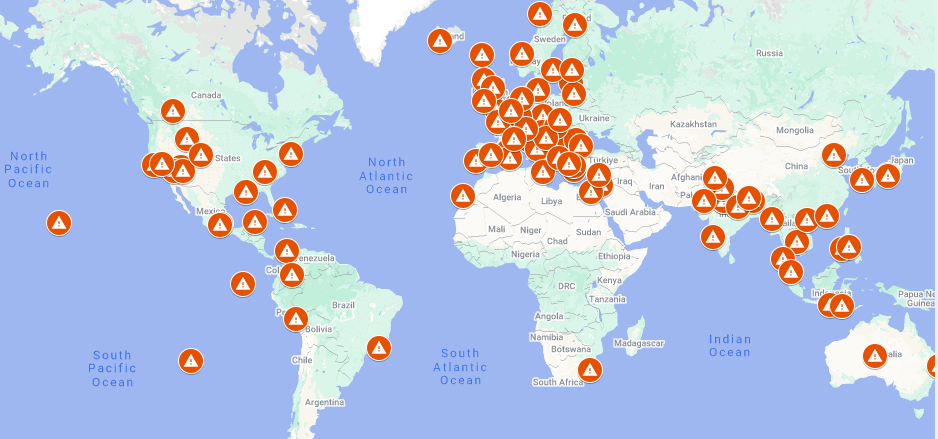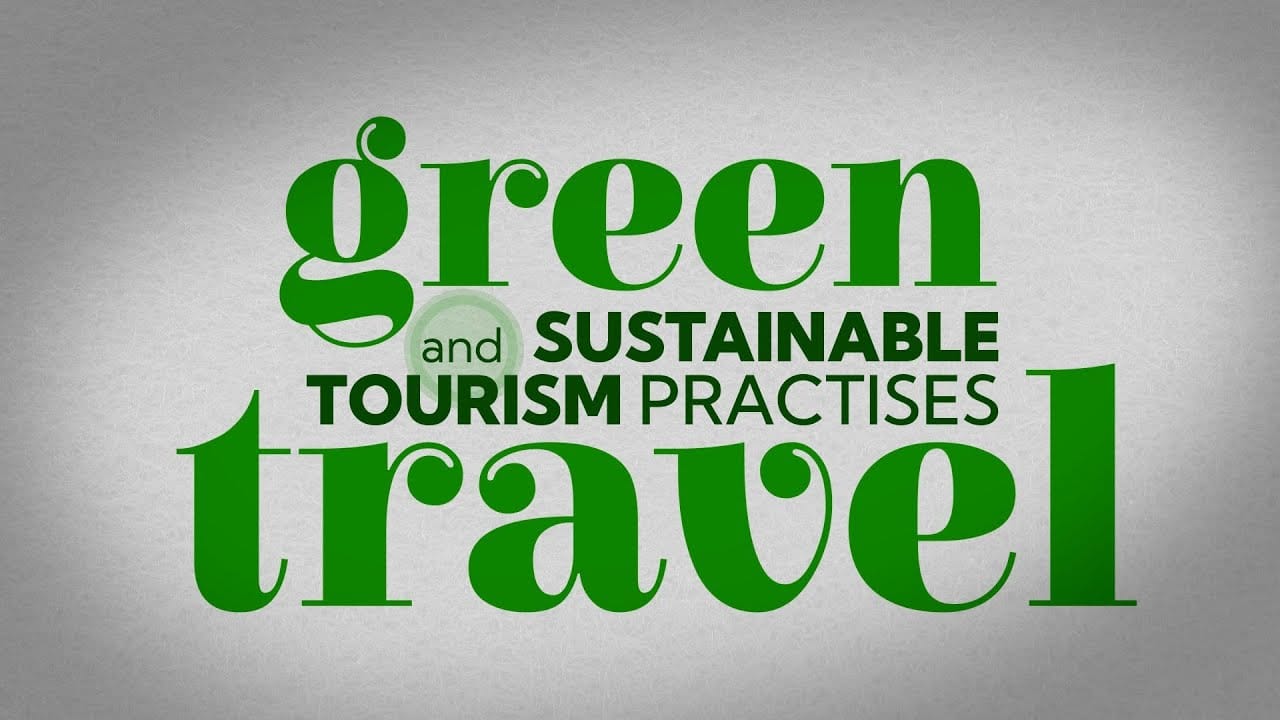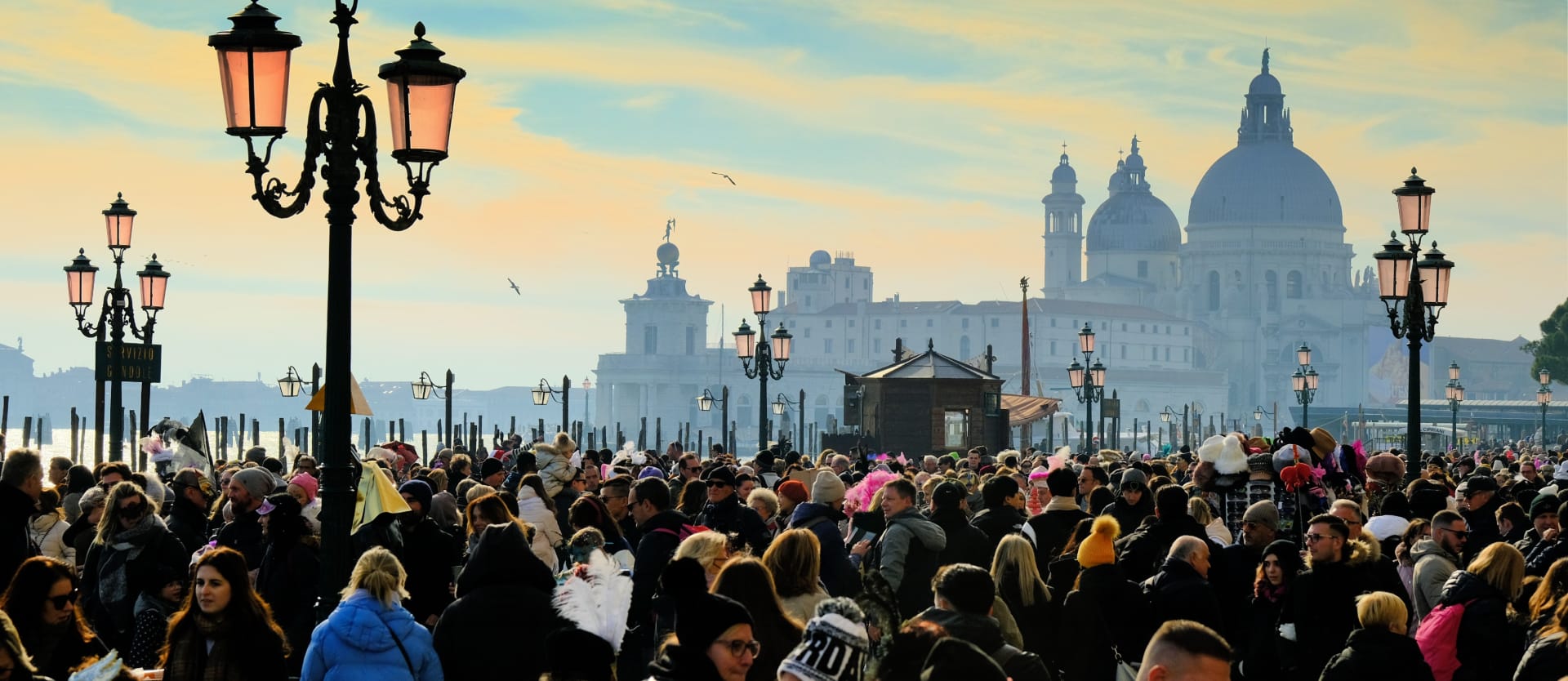Overtourism is a hot topic these days, and for good reason. As travel rises to pre-pandemic levels, some of the world’s most iconic spots feel the pressure from the greater number of visitors. Governments impose bans and raise tourist taxes, locals unite to protest – but that doesn’t seem to help.

Overtourism in numbers
So how do we balance the love of travel with the need to protect local communities and nature?
In this post, we’ll dive deep into this social issue, explore the causes and impact of overtourism, and look at what the destinations that suffer the most do about it.
What is overtourism?
Overtourism happens when a place gets way more visitors than it can handle, which leads to problems like overcrowding, damage to the environment, high prices, and a loss of local culture. Ironically, it’s when tourism starts to harm the very things that make a destination special.
The term overtourism became popular after the 2016 publication by Skift, the leading travel industry news site, when the issue was more of a mild breeze than a full-blown storm. In 2018, it was shortlisted as the Word of the Year by the Oxford English Dictionary, after the wave of mass protests against travelers swept across many cities worldwide.
Today, 98 destinations in 63 countries are grappling with the consequences of too many visitors.

The overtourism map by Responsible Travel
Why is overtourism happening: main causes
As the issue of overtourism grows, it’s important to understand what’s driving it. So let’s talk about the main factors behind this trend.
Growing income. As disposable household income grows steadily worldwide, travel becomes an attainable dream. For example, the income of European households grew 14 percent between 2013 and 2021.
Easy and affordable travel. Today, budget airlines, cheaper accommodations, and online booking platforms make travel more accessible than ever. As a result, in 2024, 1.4 billion tourists embarked on international trips.
Popular trends. “See Paris and die,” right? No wonder it retains the crown of the world's leading city destination for 4 years in a row.
Some destinations, like Venice or Bali, are on many people’s bucket lists. Also, certain travel trends, like wellness tourism or adventure tourism, can cause spikes in demand for particular locations.


Some places become popular after being featured in a movie or mentioned in relation to a celebrity.
That's what happened with Maya Bay, once a pristine Thai seaside, made famous by the movie The Beach with DiCaprio. The influx of 5,000 daily visitors caused severe environmental damage, including coral reef destruction and pollution. In 2018, the Thai government had to close the bay – the closure planned for four months turned into four years – to allow its ecosystem to recover.
The power of social media. Today, the trends are created on social media. Instagram, TikTok, and other social platforms have turned once-hidden gems into must-visit spots. A viral post can lead to thousands of visitors showing up to snap the same picture.
Global events. Events like the Olympics, world championships, concerts, or local festivals can draw massive crowds to a destination in a short period. While exciting for tourists, these events can overwhelm a city’s infrastructure, leaving locals and the environment to deal with the aftermath.


Why is overtourism a problem
The impact of overtourism is a bit of a mixed bag: On the one hand, it certainly brings in revenue. Local businesses – hotels, restaurants, shops – benefit from the influx of travelers.
But who are the actual beneficiaries? It's estimated that 80 percent of tourist spending goes to foreign-owned enterprises, and only a small share stays in the local economy.
But in any case, economic activity increases, which in turn creates workplaces and boosts the local economy, especially in areas heavily dependent on tourism.
Let’s take Hawaii as an example. With 20 percent of the local workforce involved in tourism businesses (and up to 50 percent on some islands), the total impact of travel on its economy is massive. In different periods, travel accounted for up to a quarter of the entire state's GDP! In 2024 alone, visitor spending was over $20 billion.
So no wonder that 6 out of 10 Hawaiians believe tourism brings more benefits than problems (as per the Hawaii Tourism Authority Resident Sentiment Survey 2024). Locals realize their dependence on travel – but also acknowledge the visitor-related issues.
Similarly, the Japanese government, knowing the role of tourism in their economy, is working on the “Tourism Nation Promotion Basic Plan.” The country wants to increase the number of foreign visitors to Japan from 37 to 60 million and attract over $100 million (almost double the current $55 million).
But the important part of this plan is addressing overtourism, since the "golden route" cities – Tokyo, Kyoto, and Osaka – are suffocated with excessive visitors.
So let’s talk about the main negative tourism impacts.
Economic impact (rising costs)
The demand from tourists can drive up prices for everything from food to rent to transport. This can make it harder for locals to afford basic living expenses.
Overtourism is also often blamed for housing crises in many locations. As investors build hotels and buy properties to rent out, locals face a housing shortage and higher prices.
For example, Barcelona mayor, Jaume Collboni, said that after rent rose 68 percent in the past 10 years, and the cost of buying a house rose by 38 percent, some residents could not afford an apartment. So the city authorities plan to ban short-term rentals altogether by 2028.
Similarly, economic issues stand critical for another popular Spanish destination, the Canary Islands. The community is highly dependent on tourism, which makes up almost 38 percent of its GDP. But it drove up living expenses to such an extent that 34 percent of the local population (nearly 800,000 people) are on the verge of poverty or social exclusion. Unsurprisingly, tens of thousands of people staged a protest.
However, we must admit that there’s an opposing opinion: The rise in vacation rental popularity allows locals to earn extra income renting out their properties.


Cultural impact
As destinations become more tourist-focused, local traditions and customs may be watered down or changed to cater to visitors. This can lead to a loss of cultural identity and authenticity.
For example, in many small towns like Dubrovnik in Croatia or Cusco in Peru, family-owned craft shops and other local businesses yield to tourist-oriented markets, cheap souvenir stores, or fast-food chains that outbid the lucrative rental spaces.
Besides, cultural conflicts often arise. Locals in overtouristed areas complain about the noise, bad manners, or even vandalism.
For example, Florentines were so annoyed by the endless noise that the city now bans tour guide loudspeakers. And Japanese residents were outraged by recent incidents, such as a tourist carving letters into a torii gate at Tokyo’s Meiji shrine or another tourist doing pull-ups on the torii gate at a sacred Shinto shrine.
Ecological impact (environmental damage)
Too many visitors can harm natural sites, affect wildlife, and deplete local resources. Plus, the waste management infrastructure is often insufficient to handle the extra litter, making pollution a growing concern.
Also, climate change causes a water crisis in many regions (e.g., Greek and Caribbean islands). Destinations face water shortages – and tourism is one of the causes because demand rises and water is diverted to hotels, pools, and golf courses.


The Galapagos Islands, famous for their unique wildlife, have been overwhelmed by habitat disruption, pollution, and overfishing. Another problem is invasive species, e.g., nonnative insects and parasites are a threat to the ecosystem, while abandoned cats and dogs are reported to eat endemic animals (iguanas and birds).
On top of that, the overuse of local resources and pressure on waste management systems worsen the situation. In 2010-2019, the volume of garbage on the islands grew from 18.8 tons to 28.6 tons, which local landfills just can’t cope with.
Social impact
The constant presence of tourists can lead to frustration or resentment among locals. Issues like overcrowding, rising prices, pollution, and a perceived loss of community can lead to social tensions between residents and visitors.
Sometimes, these tensions boil over and result in aggressive actions like that notorious water pistol attack in Barcelona that made headlines in July 2024.
And we all know how overcrowding ruins the charm of the place itself. Long lines, high prices, selfie pods all around you – all that destroys the experience.
So what can be done to relieve the situation?
Main strategies to address overtourism
Overtourism has been a major topic for research, conferences, and heated discussions on sustainable tourism practices, as experts seek solutions to balance economic growth with environmental and social preservation.
But who should take action? Thinking in terms of a Venn diagram of destination, travel agent, and tourist, all three parties can do their bit to relieve the situation. Here’s how.
Destination authorities can impose regulations, promote undertouristed locations (e.g., host events or develop attractions in less-known places), enhance infrastructure, offer travel cards for unlimited local travel, etc.
Travel advisors can focus on creating off-the-beaten-path itineraries to avoid overhyped places and suggest the hidden, underappreciated locations.
Travelers can make more sustainable travel choices and consider exploring less conventional destinations.
Generally, we can define several main strategy categories – which are all intertwined.
Dispersal strategies: spread visitors geographically and over time
Dispersal strategies aim to spread out visitors to avoid seasonal overcrowding in the most popular destinations.
Disperse geographically. Most people use the same travel guides and platforms for travel inspiration, i.e., Google Maps, Tripadvisor, etc., that promote the same, well-recognized places. But the world is so big, and much of it is undeservedly disregarded.
And one of the major travel trends today is experiential travel as people strive for unique, more authentic adventures. So highlighting less-traveled spots is a win-win.
So lately, Booking.com and other tech platforms have started adding AI-suggested recommendations of under-visited destinations. Why go to overcrowded Santorini or Mykonos? The Greek archipelago has over 200 inhabited islands, many of which (like Ios, Anafi, etc.) have rich history, beautiful landscapes, and serene beaches.
Or take Amsterdam. The city suggests Haarlem as a great nearby alternative. Just a 20-minute train ride away (included in the Amsterdam & Region Travel Ticket), Haarlem offers historic charm, vibrant arts, and cozy cafes – minus the crowds.
These dispersal promotions seem to be working well, as reported by Portugal, Greece, and Spain. These measures alone aren’t enough to fully relieve the overtourism burden, but they still alleviate the pain at least partially. The European Travel Commission also notes that a “growing share of Europeans plan to travel beyond Europe’s tourism hotspots.”
The report also highlights the rise in off-season travel.
Disperse over time. To avoid peak season overcrowding, it’s sensible to spread visitors out over time. It can be done by arranging events and promoting experiences in shoulder periods and off-season, offering dynamic pricing for travel products, and setting timed entry for busy attractions.
Cities can use crowd detection technology to control traffic flows. Also, promoting apps like Crowd Alert can help guide tourists to less crowded times and places.
In fact, travelers themselves realize the benefits of off-season travel. So, whether due to actions taken or mere common sense, shoulder travel has emerged as one of the travel trends in recent years. It’s especially true for more flexible categories, such as high-end tourists and solo travelers.
Restrictions and regulations: fees, limits, bans
By taking restrictive measures, cities and attractions can potentially reduce the number of tourists.
Entry fees and city taxes. Charging people for entering the territory ensures that only those who are genuinely interested in the experience will visit. At the same time, promoting fee-free locations can help disperse visitors.
Many countries and cities have introduced a city tax. While too low to scare away most visitors, this money funds maintenance activities (repairs, garbage removal, etc.) and infrastructure development.
Read more about tourist taxes in our detailed overview.
Access limits. Some measures here are implementing timed entry, capping visitor numbers, or restricting certain activities.
For example, Barcelona restricts access to its Park Güell. Machu Picchu limits the daily number of visitors to 4,500 in the low season and 5,600 in the high season – all divided into different routes to disperse visitors around the site. Most popular coastal towns like Venice, Dubrovnik, or Amsterdam have capped the number of cruise ships allowed in the port.
All that aims to create a more manageable and sustainable tourist flow. And it works well in many places. A great example are the Cies islands that capped daily visitors at 1,800 and now enjoy some breathing room. However, these measures don’t seem to help in severe cases like Venice.
Lodging regulations. Many cities regulate short-term rentals, capping their number, introducing licensing rules, setting the number of days that a lodging facility can be rented out, etc.
The idea is to keep the accommodation market sustainable and balanced, making it easier for residents to find affordable housing – while still offering enough options for tourists. Looking at New York and other big cities, these regulations might not drive prices down, but they may prevent them from further rampant growth (as there are lots of other factors that impact prices). Besides, the locals complain less about the noise and crowds.
Additionally, some destinations like Amsterdam and Barcelona take a step further and ban new hotel construction to limit room availability for visitors.
Development and education
Development and promotional strategies aren’t about curbing tourist numbers. They are about making travel more sustainable.
Infrastructure development. Enhancing infrastructure and facilities ensures that the city is ready for tourists without making life harder for locals. Some steps cities take include
- adding new public transport routes to better handle passenger traffic and reduce the number of cars on the streets,
- adding accessibility options and signage in popular destinations to guide travelers and minimize congestion,
- offering online booking systems to minimize queues,
- enhancing waste management systems to better process excessive garbage, and so on.
For example, Thai authorities consider developing secondary airports and incentivizing airlines to redirect some air traffic from congested main airports. Also, they encourage local authorities to establish regular public transportation routes that connect those regional airports to major cities.
Another long-term project is the construction of two additional airports to handle growing traffic.
Education and promotions. Educating visitors about the local culture, traditions, and tourism impact can help them be more mindful of their actions and impact. That also includes
- suggesting greener travel options,
- offering classes on traditional crafts,
- encouraging choosing local businesses instead of global chains,
- promoting “slow travel” for a deeper immersion, etc.
Some destinations launched promotional programs to encourage sustainable tourism. For example, Hawaii’s “Mālama Hawai'i” initiative has been promoting volunteer activities since 2020, suggesting visitors participate in activities like shore cleanups, native tree planting, etc.
Rewards for taking part include discounts or free hotel nights. Moreover, visitors who have participated in the program report “enriched travel experiences and a profound sense of fulfillment.”
Similarly, Copenhagen has launched CopenPay, rewarding visitors for climate-friendly actions, like biking, using public transportation, or even collecting waste. In return, tourists can earn freebies such as museum tours, kayak rentals, or locally sourced meals.
The 2024 pilot was a huge success: Over 5,000 people contributed thousands of hours of volunteering with a 100 percent satisfaction rate. The city witnessed a 29 percent increase in sustainable transportation and got rid of 1,200 kg of trash. So in 2025, the program returned on a larger scale.
In their effort to address the problem, most destinations support restrictive measures such as taxes and bans, while some believe in a more easy-going approach. Probably, the sweet spot is somewhere in between – or a combination of the two.
Canary Islands and Oaxaca, Santorini and Koh Samui, Lisbon and Mallorca – though in different parts of the world, all suffer from the same problem. While relying on tourism as a major contributor to the economy, these places are burdened by the influx of visitors and must adopt a mix of strategies to drive more responsible “quality tourism” over mass travel.

Maria is a curious researcher, passionate about discovering how technologies change the world. She started her career in logistics but has dedicated the last five years to exploring travel tech, large travel businesses, and product management best practices.
Want to write an article for our blog? Read our requirements and guidelines to become a contributor.

